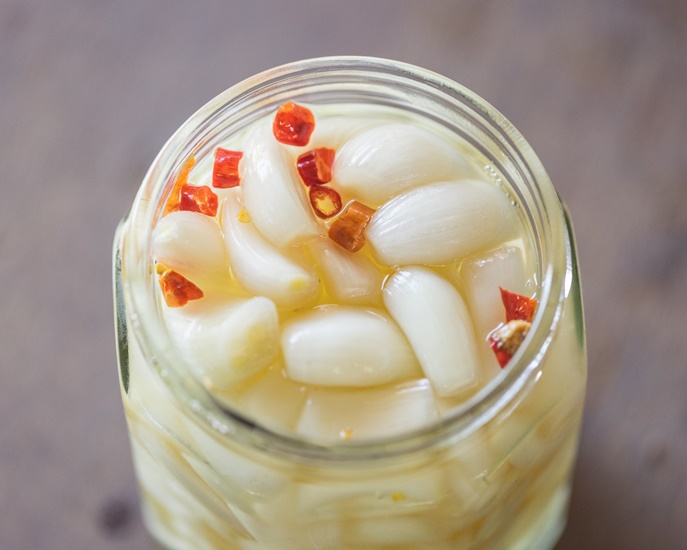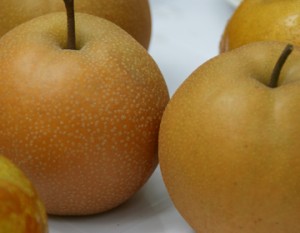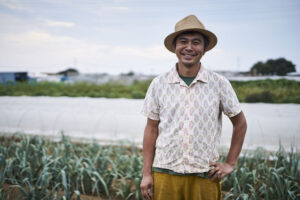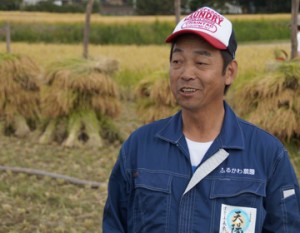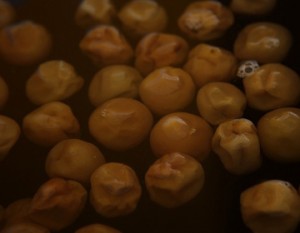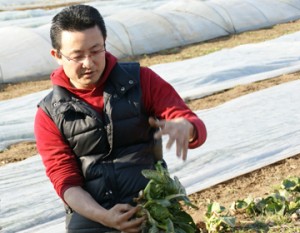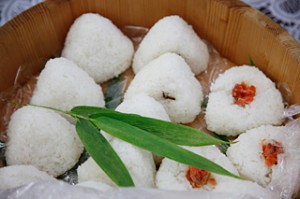Dune Rakkyo” has a crunchy texture that grows because of the sand dunes. In 2016, it was certified as a “Geographical Indication (GI)” product, which protects specialty products that make the most of regional characteristics, and its name continues to spread.
Fukube-cho, Tottori City, where Tottori Sand Dunes are right in front of you.

The Tottori Sand Dunes, stretching approximately 16 km east to west along the coast of the Sea of Japan in northern Tottori Prefecture, is a major production area of rakkyo. Of this area, only about 2 km is visited by many people as a sightseeing spot. The rest of the sand dune area is covered with fields of cucumber. Rakkyo is easy to grow even in poor soil, and there are many places in Japan where it is cultivated in sandy soil. In Fukube Town, about 60 farmers are engaged in the cultivation of rakkyo, and the amount of rakkyo shipped is one of the highest in Japan.
Jewel of the Dunes, Dune Rakkyo

One of the characteristics of dune cucumbers is their crunchy texture. In land with high moisture and nutrients, the fruit of rakkyo tends to grow larger, and the thickness of the inner skin (inner scales) and outer skin (outer scales) differs. On the other hand, in the Tottori Sand Dunes, less moisture in the soil is loaded, resulting in the growth of rakkyo with thinner individual skins and tighter flesh. The long oval-shaped variety known as the camel type is a good match, and the more even the thickness of the inner and outer scales is, the more crisp it becomes, so that the rakkyo from the Tottori Sand Dunes grown in this harsh environment has a surprisingly light texture.
In addition, when grown in areas with low nutrients, rakkyo tends to become pale in color. It is precisely because the Tottori Sand Dunes have low water and fertilizer retention capacity that pure white, clear, and beautiful rakkyo can be grown. The shiny, sparkling appearance of the radishes is the reason why they are nicknamed the “Jewel of the Dunes.
100 Years of History of Dune Rakkyo

Mr. Kagawa, a producer of dune cucumbers, says, “Actually, the history of dune cucumbers is very old. Mr. Kagawa is a veteran grower of Sunaoka Rakkyo, who has been cultivating it while working as a company employee.
There is a theory that it was brought back to Japan by participants in the Edo period (1603-1867), but it was not until the Taisho period (1912-1926) that full-scale cultivation began. Until then, they had grown pears, watermelons, and other fruits, but the fruits did not grow large due to a lack of water retention capacity. So, after experimenting with various crops, they found that rakkyo was suited for this purpose. Later, from the 1960s, processing and other activities began to take place, and the business became even more prosperous,” he said.
In 2014, it celebrated 100 years since the start of sales, and in 2016, “Tottori Sand Dune Rakyo and Fukube Sand Dune Rakyo” were registered under the “Geographical Indications Protection System (GI),” a system to protect crops grown with the blessings of the land as local intellectual property. GI is a system to protect the intellectual property of a region. The quality of the product has been recognized by the government, and the product has been successfully branded as “Tottori is known for its dune-rakyo”.
Cultivation of rakkyo under harsh conditions

The rakkyo plants are planted by hand, one by one, from July to September. In October, the plants come into bloom, and their pretty reddish-purple flowers spread like a carpet across the Tottori Sand Dunes.

It then slowly grows in the sand and winters under the snow in December. When planted, the cucumbers grow from one to six to eight.
The structure of the cucumber is like a small onion, with the leaves growing on top of the sand and the main body growing in the sand.
Therefore, it is difficult to judge whether they are diseased or growing well. We have to judge by looking at the leaves, fertilize, disinfect, and control insects. We don’t know how the year is going to turn out until we harvest the crop, so every year is like the first time for me,” says Kagawa.
Faceting work requiring experience

The most difficult time is during the harvest season from May to June. Every day, 1,300 kg of rakkyo must be dug up and the roots and stems cut by hand.
When shipping, they are divided into two types: “rooted” or “rooted” rakkyo, in which only the unneeded stems are removed and shipped as bundles, and “washed” rakkyo, in which not only the stems but also the roots are cut off, pickled in salt, and shipped. Since both types of processing are done by hand, each farmer must gather several dozen staff members called “Kiriko” (cutters). In particular, the processing of washed rakkyo requires a skilled workforce, as each ball must be divided into individual pieces and cut into appropriate sizes.
It takes time to get used to the work, and it is hard to gather the “kiriko” because the work is only done for one month. It takes time to get used to it, and the smell is tough. If we don’t do something about this, I don’t think we will be able to attract more young people,” he says.
He cuts the rakkyo through a rapeseed knife set up on his desk. Since they are paid by the amount they cut, they need to accumulate a certain amount of experience to earn money. Since the number of veteran cutters is decreasing, the company is exploring the possibility of mechanizing the cutting process in cooperation with agricultural cooperatives and companies.
Recipes created by a farmer who knows all there is to know about Japanese cucumber

In order to spread the use of their lovingly cultivated cucumbers, Mr. Kagawa and his colleagues have been holding a workshop on how to make easy pickles of cucumbers. Normally, when making sweet-and-sour pickled curakyo, it is necessary to soak the curakyo in salt water for about two weeks, but that takes a lot of time and effort. In order to make it easier for people to enjoy pickling, we teach “kantanzuke” pickling, which can be done on the same day of purchase.
The procedure is simple. First, cut the root and stem of the rakkyo and wash them under running water, rubbing them until the thin skin peels off. After sprinkling salt on the radish and washing it again, run it through hot water for 10 seconds. After draining the water, put the cucumber in a sterilized jar and pour the vinegar into the jar. The easy way to pickle cucumbers is to pickle them right at home. I would like young people to pickle curacao because it has high nutritional value. I want them to enjoy the fun of pickling by themselves,” says his wife, Saeko, who also takes the initiative in teaching the young people how to pickle their own vegetables.
I want you to eat it as the star of the show, not the supporting cast.

They also offer a variety of recipes for rakkyo with the hope that people will eat it as the main ingredient rather than as a side dish. We recommend the “Yaki-rakkyo” recipe, which can only be made with freshly harvested rakkyo. It is made by pan frying the rakkyo and quickly tossing it in a soy sauce and mirin (sweet sake and mirin) pickling sauce. It can be served hot or cold.

Other dishes that are not usually seen on the menu include “Rakki-katsu,” a deep-fried pork cutlet wrapped in sweet vinegared rakkyo and seasoned with soy bean sauce, and “Flower Rakkyo,” a refreshing dish served with ham, turnips, and shiso leaves. The main reason for this is that it is important for consumers to know simple and tasty recipes in order to encourage them to buy and eat them,” said Mr. Kato. We hope you will try them in a different way and enjoy them as the star of the show,” Mr. and Mrs. Kagawa told us.
For the Future of Japanese Rakhi Farmers

Growing rakkyo on sand dunes is not easy. Because of the lack of water retention, a large amount of fertilizer and water must be applied, and because no other crops can be grown on the dunes, disinfection work is necessary to prevent continuous cropping (i.e., the continuous production of the same crop results in unbalanced nutrients in the soil, which makes it difficult for the crop to grow).
However, except during the busy harvest season, the working hours can be adjusted, and the farmers can be independent with just one cucumber. Above all, the more work you put in, the more delicious your Rakkyo will be. The joy of harvesting the bright white, shiny, and shimmering Rakkyo is even greater when they are grown.
The number of young people is gradually increasing, but the problem is that the cutting process is manual and takes a lot of time and manpower. We are working to improve this part of the process through mechanization. I would be happy if more and more people learn how fun it is to make kyokkyo and if the number of kyokkyo farmers increases,” says Kagawa.
Sunaoka Rakkyo is beginning a new 100-year history.



